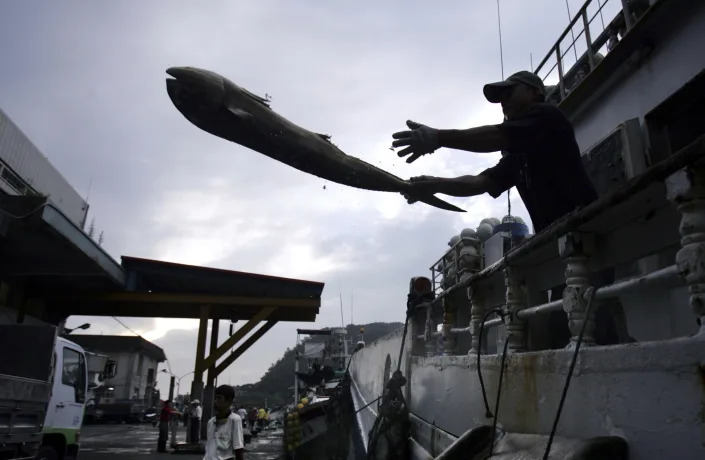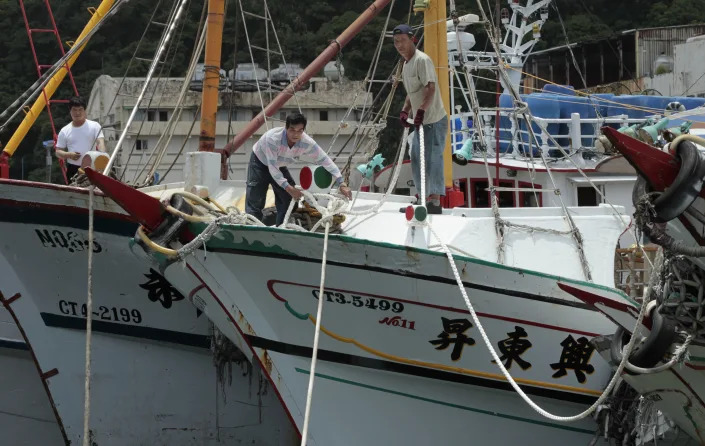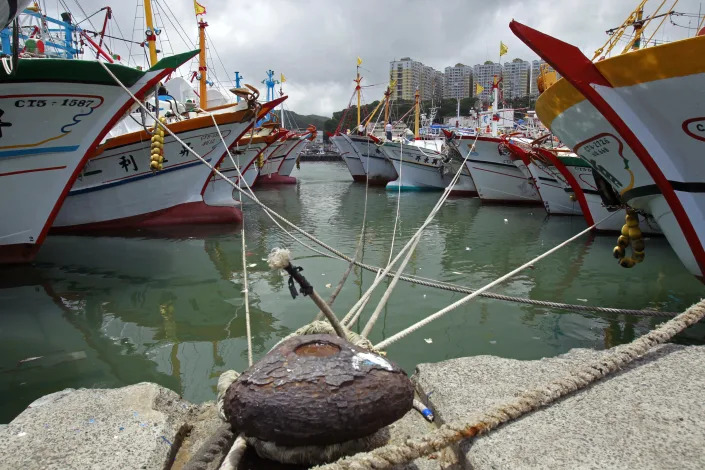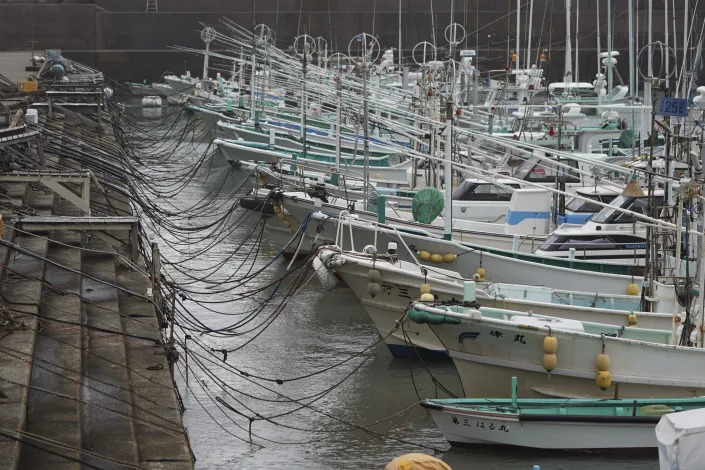



Fishing boats are anchored at a port in the town of Kiho, Mie Prefecture, Japan Friday, Oct. 11, 2019. More than 100,000 people die in fishing related accidents a year, more than triple earlier estimates, and many of those fatalities were preventable, according to a report released Thursday, Nov. 3, 2022.
(AP Photo/Toru Hanai)
ELAINE KURTENBACH
Thu, November 3, 2022
BANGKOK (AP) — More than 100,000 people die in fishing-related accidents each year, more than triple earlier estimates, and many of those fatalities were preventable, according to a report released Thursday.
A range of factors are contributing to the problem, including abuses by fishing operators, use of child labor, overfishing, climate change, armed conflicts and poverty, said the report, based on research by the Fish Safety Foundation commissioned by the Pew Charitable Trusts.
Illegal, unreported and unregulated fishing has been increasing despite efforts to curb such practices, as overfishing has led fleets to travel ever further in search of catches, adding to the risks.
“With 3 billion people reliant on seafood and the demand expected to rise, stronger policies are urgently needed to keep fishers safe, including ones that address the true drivers of these deaths," Peter Horn, a project director with Pew International's fisheries project, said in a statement.
Operators of fishing fleets often fail to report deaths, obscuring the reality of the dangers in the industry and making it difficult for governments to design effective policies to improve safety, said Eric Holliday, chief executive of Fish Safety Foundation, an international non-profit group promoting safer fishing.
Not all of the deaths are among huge fishing fleets, where forced labor and other abusive practices have been widely documented.
Private, traditional fishing has become increasingly risky because fishers must travel ever further as waters closer to shore are overfished or fish migrate to more distant seas due to climate change, the report said. Meanwhile, many governments have cut back on patrols and search and rescue missions, partly due to the rising cost of fuel.
The report's authors compiled their fishing mortality estimate of over 100,000 deaths annually based on publicly available data cross-referenced with news reports, social media and discussions with government officials and others.
But much of the data was compiled in the 1990s and needs updating. According to those estimates, which are based on industry and U.N. data, the highest fatality rates are in African fisheries and the Pacific Islands. Fatality rates in the report released Thursday ranged from 207 per 100,000 people in Finland to under 6 per 100,000 in Poland.
The problem is not confined to ocean-going fishing vessels — on Lake Victoria in Africa, between 1,800-5,000 people per 100,000 are estimated to perish each year.
The report cited Godfrey Kiwanda, the former state minister for tourism in Uganda, as saying the number may be much higher since many deaths happen in remote dams and swamps and are not officially reported.
Another neglected hazard is decompression sickness among divers forced to make repeated deep dives, a common problem in harvesting lobster, sea cucumbers and conches, the report said.
Among the most hazardous fishing industries are raft fisheries in Myanmar. Thousands of men are recruited each year, paid about $450 in advance, to stay for a few months on small bamboo platforms on top of foam blocks up to 100 kilometers (about 60 miles) offshore. Working in small teams, they catch fish and shrimp using nets they lower into the water, suffering from a lack of fresh water and food at times if supply boats fail to visit often enough.
Ulcers, beriberi from lack of vitamin B, tuberculosis, and burst arteries are among the ailments common among those workers, the report said, citing local doctors.
ELAINE KURTENBACH
Thu, November 3, 2022
BANGKOK (AP) — More than 100,000 people die in fishing-related accidents each year, more than triple earlier estimates, and many of those fatalities were preventable, according to a report released Thursday.
A range of factors are contributing to the problem, including abuses by fishing operators, use of child labor, overfishing, climate change, armed conflicts and poverty, said the report, based on research by the Fish Safety Foundation commissioned by the Pew Charitable Trusts.
Illegal, unreported and unregulated fishing has been increasing despite efforts to curb such practices, as overfishing has led fleets to travel ever further in search of catches, adding to the risks.
“With 3 billion people reliant on seafood and the demand expected to rise, stronger policies are urgently needed to keep fishers safe, including ones that address the true drivers of these deaths," Peter Horn, a project director with Pew International's fisheries project, said in a statement.
Operators of fishing fleets often fail to report deaths, obscuring the reality of the dangers in the industry and making it difficult for governments to design effective policies to improve safety, said Eric Holliday, chief executive of Fish Safety Foundation, an international non-profit group promoting safer fishing.
Not all of the deaths are among huge fishing fleets, where forced labor and other abusive practices have been widely documented.
Private, traditional fishing has become increasingly risky because fishers must travel ever further as waters closer to shore are overfished or fish migrate to more distant seas due to climate change, the report said. Meanwhile, many governments have cut back on patrols and search and rescue missions, partly due to the rising cost of fuel.
The report's authors compiled their fishing mortality estimate of over 100,000 deaths annually based on publicly available data cross-referenced with news reports, social media and discussions with government officials and others.
But much of the data was compiled in the 1990s and needs updating. According to those estimates, which are based on industry and U.N. data, the highest fatality rates are in African fisheries and the Pacific Islands. Fatality rates in the report released Thursday ranged from 207 per 100,000 people in Finland to under 6 per 100,000 in Poland.
The problem is not confined to ocean-going fishing vessels — on Lake Victoria in Africa, between 1,800-5,000 people per 100,000 are estimated to perish each year.
The report cited Godfrey Kiwanda, the former state minister for tourism in Uganda, as saying the number may be much higher since many deaths happen in remote dams and swamps and are not officially reported.
Another neglected hazard is decompression sickness among divers forced to make repeated deep dives, a common problem in harvesting lobster, sea cucumbers and conches, the report said.
Among the most hazardous fishing industries are raft fisheries in Myanmar. Thousands of men are recruited each year, paid about $450 in advance, to stay for a few months on small bamboo platforms on top of foam blocks up to 100 kilometers (about 60 miles) offshore. Working in small teams, they catch fish and shrimp using nets they lower into the water, suffering from a lack of fresh water and food at times if supply boats fail to visit often enough.
Ulcers, beriberi from lack of vitamin B, tuberculosis, and burst arteries are among the ailments common among those workers, the report said, citing local doctors.
No comments:
Post a Comment